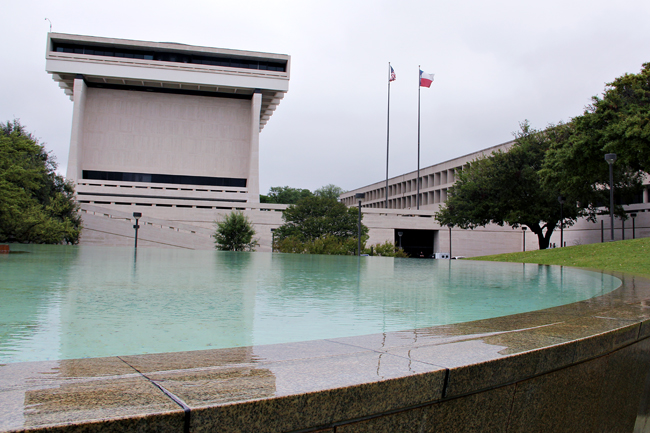While Austin is under stage two watering restrictions, the University, which is not required to follow city ordinances, will run the LBJ Fountain through the Civil Rights Summit on Tuesday, Wednesday and Thursday.
Since 2012, the city has been in stage two, which restricts the owners of multi-family residential, commercial or city municipal facilities to watering one day per week in the early morning or late evening.
According to Laurie Lentz, UT business and financial services communications manager, when the city went into watering restrictions, the University decided to adhere to these regulations voluntarily.
“UT is considered a state entity and does not have to adhere to city ordinances,” Lentz said. “Nowadays, the state entities go along with what the city entities are doing, but they are not actually bound to that.”
Lentz said there are 14 decorative fountains on campus. Three fountains — LBJ Fountain, Littlefield Fountain and East Mall Fountain — operate 24/7 for filtering purposes with no spray features. Lentz said if the University turned on the spray features regularly, it would lose 300,000 gallons of water a month, which would require added water.
Jill Mayfield, Austin Water Utility spokeswoman, said the University typically follows city ordinances and conserves water.
“UT does a great job of really working with us even though they don’t have to by law,” Mayfield said. “I know the Civil Rights Summit is a huge event, and they want to look nice.”
Markus Hogue, UT’s irrigation and water conservation program manager, said his department has also had to do a lot of work on the LBJ Library lawn in preparation for summit.
Hogue said new flowers have been planted, beds have been cleaned out and new mulch has been laid down. Although establishing new turf requires more watering, Hogue said the grass does not require more water than usual.
“Now all that mulch [gets]rainfall stores, so when I irrigate that area, I don’t have to run it as long because I don’t have to worry about not [having] the moisture in the ground,” Hogue said. “It holds on to it better.”
According to Hogue, in 2012 the University used around 75 million gallons of water to irrigate, which was almost a 100 million gallon reduction after $2.1 million were used in 2011 to install new nozzles and controllers to regulate how much water was being used.
The University now uses a rainwater collection system at the Belo Center for New Media for irrigation. Hogue said half a million gallons of rainwater was collected last year, which allowed the University to use less fresh drinking water to maintain the landscape.
According to Hunter Mangrum, Division of Housing and Food Service environmental specialist, the University’s residence halls have even taken steps to become more environmentally friendly on campus. Mangrum said the University has its own stages for watering restrictions depending on the amount of water in the rain collection tanks at the two residence hall gardens.
If the garden tanks fall below 30 percent full, the watering schedule is reduced to each bed, which receives 15 minute watering cycles two times per week.
“The city is in stage two, and we do comply with that as much as possible, and in fact, the watering systems for those gardens are totally self sufficient,” Mangrum said.





















